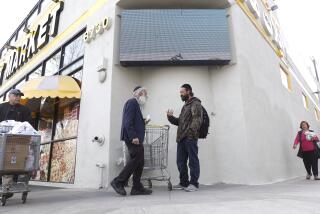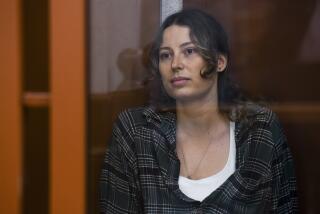Russian Cultural Center Designed to Bridge a Gap
They weren’t fighting in the streets and, in fact, West Hollywood’s American and Russian-immigrant communities rarely quarreled. But maybe they should have, thought Zigmund Vays--at least there would have been some meaningful interaction.
Instead, many of the city’s 5,000 Soviet immigrants, mostly Jewish senior citizens who found it difficult to learn English and adjust to this country’s culture, avoided contact with Americans, forming small “cultural ghettos,” Vays said.
“They would all live in the same neighborhood, where no English would be spoken in the homes or businesses, and they wouldn’t mingle with Americans,” he said. “The Soviet society is very claustrophobic. It is generally very closed and afraid of anything new.”
In turn, the city’s 33,000 other residents, largely senior citizens or homosexuals who do not speak Russian or understand the life style, found it difficult to reach out to their new neighbors, many of whom fled the Soviet Union to escape anti-Semitism.
Although West Hollywood has one of the largest concentrations of Soviet immigrants west of Brooklyn, Vays has been the only Soviet immigrant to serve on any of the city’s eight boards or commissions since the city’s incorporation four years ago, and only a few of the city’s staff members speak Russian.
City officials admitted that recruitment efforts are lacking, but Vays said most Soviet immigrants do not apply for government posts because they do not understand the concept of government by the people and for the people.
“This community is in serious need of integration, consolidation and cross-cultural education,” he said. “It’s not easy, because there is resistance and misunderstanding on both sides.”
To create a forum for such education, Vays persuaded the West Hollywood City Council to spend $50,000 to establish a Russian Cultural Center. The center has served more than 100 people since it opened last month in a Jewish temple at Crescent Heights Boulevard and Fountain Avenue.
City Councilman Steve Schulte said the council, concerned by the Russian community’s lack of involvement in government affairs, “decided it might help to give them a focal point, much like the Gay and Lesbian Center or the Senior Citizens Center, where they could organize events and increase their participation in the community.”
Immigrants and Americans of all ethnic groups will be invited to the center, administered by the Assn. of Soviet Jewish Emigres, to participate in film festivals, plays and variety shows. Elected officials also will be invited to help educate the immigrant community about its civic responsibilities, Vays said.
“There are several agencies involved with resettlement of the immigrants, but after an immigrant finds a place to live, a place to work, and has no need for financial assistance, life goes on and there are serious cultural barriers that they have to overcome,” he said.
Daily Questions
“They have questions every day that, to most Americans, are common knowledge--like checkbooks. That’s something that does not exist in Russia. Neither do push-button phones, and many people have never eaten in Chinese restaurants or driven cars.”
West Hollywood’s large gay community also shocked most immigrants, Vays said.
“They come from Russia, where they see homosexuals jailed, to West Hollywood,” where gays are part of the power structure, he said. “It’s a tremendous experience for (immigrants.)”
Aron Khait, 81, and his wife, Yetta, 76, said that when they moved to West Hollywood from the Soviet Union 10 years ago they did not know how to live in a free society.
“We were like caged animals who had been set free,” Yetta Khait said. “But we did not know what to do with all our freedom and we were afraid to go out too far or try new things because we might get lost.”
Aron Khait, a retired toolmaker, said most of the Americans he has encountered are friendly. However, others, he said, asked him, “If you had food and a roof over your heads, why would you want to leave?”
“They do not understand the constant fear and persecution we suffered as Jews in that country and that we wanted more in life than food and shelter,” he said.
Immigrants seeking citizenship can take free classes to prepare for the exam, and teacher Marina Lankpey said her sessions are different from those organized by resettlement agencies because they do not focus on history. Practice interviews are used to teach the candidates how to conduct themselves and how to give more than one-word answers during the exam.
Citizenship student Gregory Schumyachar, 68, who served 35 years in the Soviet military before he moved to West Hollywood five years ago, said, “It’s great (at the center) because Marina can explain the material to us in Russian. In other classes, the teacher only speaks English and the books are all written in English, so it is very hard to understand.”
He added, “This center should be a bridge where the Americans and Russians can meet to learn about each other and enjoy each other socially.”
Actor and playwright Jim McKeny agreed. To learn more about Russian life and language, he enrolled in the center’s free Russian-as-a-second-language class.
As he sat with 20 classmates around two second-hand tables in the modest classroom, McKeny said, “I’ve always been fascinated with (the Soviet Union) and its people. I know the people are different than what most Americans think, because a friend of mine who went to the Soviet Union keeps telling me how warm and friendly they were.”
The center’s series of artistic events will kick off with a gala opening show Nov. 19 at Plummer Park. Cultural coordinator Larisa Eryomina, an actress who made 14 films before she moved to the United States nine years ago, said the show will feature several Soviet performers, such as singer Larisa Chirkova and Ella Goncharova, Latino dance troupes and actor Richard Green, who has had roles in such television series as “Hotel,” “Hill Street Blues” and “St. Elsewhere.”
Eryomina, who graduated from the Moscow Art Theater Institute and teaches acting at UCLA, said she is confident that the common love of art will be effective in bonding the American and Russian-immigrant communities.
“Culture and art come from the heart and soul,” Eryomina said. “Inside, there is no hardness. Just desires to be at peace.”
More to Read
Sign up for Essential California
The most important California stories and recommendations in your inbox every morning.
You may occasionally receive promotional content from the Los Angeles Times.










